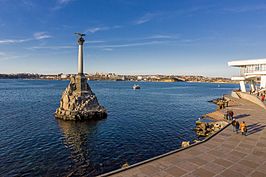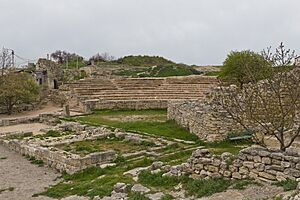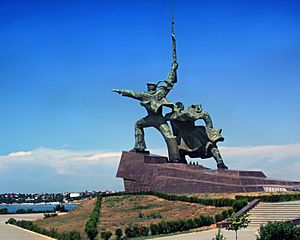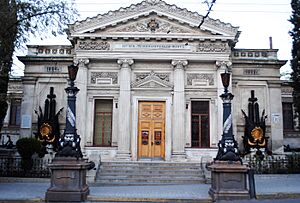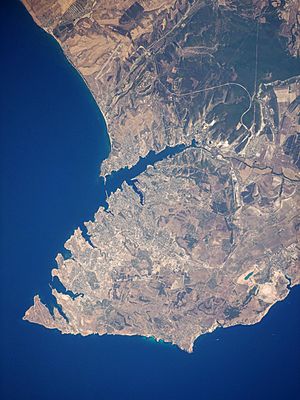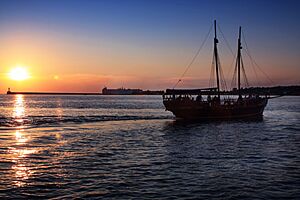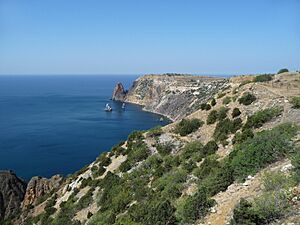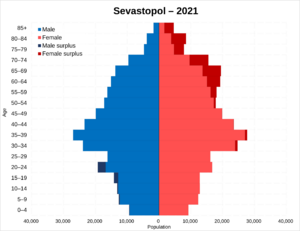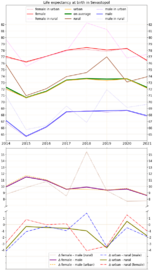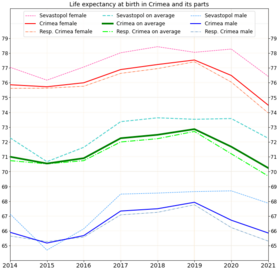Sevastopol facts for kids
Quick facts for kids
Sevastopol
|
|||
|---|---|---|---|
|
|||
| Anthem: "Легендарный Севастополь" (Russian) (English: "Legendary Sevastopol") |
|||

Orthographic projection of Sevastopol (in green)
|
|||
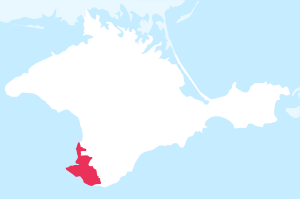
Map of the Crimean Peninsula with Sevastopol highlighted
|
|||
| Lua error in Module:Location_map at line 416: Malformed coordinates value. | |||
| Country (de facto) | |||
| Federal Subject (Federal City) (de facto) | Sevastopol | ||
| Federal District (de facto) | Southern | ||
| Economic Region (de facto) | North Caucasus | ||
| Country (de jure) | |||
| City with special status (de jure) | Sevastopol | ||
| Founded | 1783 (242 years ago) | ||
| Government
(Russia (de facto))
|
|||
| • Body | Legislative Assembly | ||
| Area | |||
| • City | 864 km2 (334 sq mi) | ||
| Elevation | 100 m (300 ft) | ||
| Population
(2021)
|
|||
| • City | 547,820 | ||
| • Density | 634.1/km2 (1,642.2/sq mi) | ||
| • Urban | 479,394 | ||
| Demonym(s) | Sevastopolitan, Sevastopolian | ||
| Time zone | UTC+03:00 | ||
| Gross regional product | ₽168.574 billion (€Undefined year "2021" billion) ₽326,677 (€Undefined year "2021") |
||
Sevastopol is a large city and important port on the Black Sea. It is located in Crimea. Because of its great location and good harbours, Sevastopol has always been a key port and naval base. Since it was founded in 1783, it has been a main base for Russia's Black Sea Fleet.
During the Cold War in the 20th century, Sevastopol was a closed city. This meant that people who did not live there needed special permission to visit. The city covers about 864 square kilometers, including some rural areas. Most people live near Sevastopol Bay. The city has a population of about 547,820 people.
Sevastopol is seen by most countries as part of Ukraine. Under Ukrainian law, it is one of two cities with a special status, like Kyiv. However, Russia has controlled it since February 2014. Russia then took over Crimea in March 2014, making Sevastopol a federal city of Russia. Both Ukraine and Russia see Sevastopol as separate from the rest of Crimea. Most people in Sevastopol are Russians, but there are also many Ukrainians and Crimean Tatars.
Sevastopol's strong connection to the navy and sea has helped its economy. The city has mild winters and warm summers. This makes it a popular place for tourists, especially from countries that used to be part of the Soviet Union. It is also an important place for marine biology research. Since the 1960s, the military has even studied and trained dolphins here for special uses.
Contents
What's in a Name?
The name Sevastopol comes from ancient Greek words. It means "venerable city." The word sebastos means 'venerable' and pólis means 'city'. Sebastos is like the Roman title Augustus, which was given to Roman emperors.
The city was likely named after Empress Catherine the Great of the Russian Empire. She founded Sevastopol in 1783. She visited the city in 1787 with other important people.
West of the city, you can find old ruins of the ancient Greek city of Chersonesos. It was built in the 5th century BC by settlers from Heraclea Pontica. Its name means "peninsula," which describes its location.
The city's name is spelled in different ways:
- English: Sevastopol (most common now), or Sebastopol (used in the past).
- Ukrainian: Севасто́поль (Sivastopol').
- Russian: Севасто́поль.
- Crimean Tatar: Aqyar.
A Look Back: Sevastopol's History
Ancient Times: Chersonesus
Around 600 BC, Greek settlers built a colony where Sevastopol is today. This Greek city, Chersonesus, lasted for almost 2,000 years. It started as a free democracy and later became part of the Bosporan Kingdom. In the 13th and 14th centuries, it was attacked many times by the Golden Horde. Eventually, it was completely abandoned. Today's Sevastopol is not directly connected to this ancient city, but its ruins are a popular tourist spot.
Becoming Part of the Russian Empire
Sevastopol was founded in June 1783. It was first called Akhtiar, meaning 'White Cliff'. It was built as a naval base by Rear Admiral Thomas MacKenzie. This happened soon after Russia took over the Crimean Khanate.
In February 1784, Empress Catherine the Great ordered a fortress to be built there and named Sevastopol. Captain Fyodor Ushakov oversaw the building plans. The new settlement quickly became an important naval base and later a busy seaport. In 1797, Emperor Paul I changed its name back to Akhtiar. But in 1826, the city's name was officially changed back to Sevastopol.
The Crimean War (1853–1856)
From 1853 to 1856, the Crimean peninsula was a key battleground in the Crimean War. Russia fought against an alliance led by France and Britain. The allies wanted to attack Sevastopol because it was Russia's main naval base on the Black Sea.
Allied forces landed in Crimea in September 1854. They marched south of Sevastopol after winning the Battle of the Alma. The Russians fought back in the Battle of Balaclava, but the allies held their ground. Another Russian attack at Inkerman also ended in a draw. The fighting then turned into a long siege of Sevastopol. Conditions for soldiers on both sides were very harsh.
Sevastopol finally fell after eleven months. This happened after French forces attacked Fort Malakoff. Russia then asked for peace in March 1856. The Treaty of Paris ended the war. It also stopped Russia from keeping warships in the Black Sea for a time.
World War II (1941–1944)
During World War II, Sevastopol faced heavy attacks from German forces and their allies in 1941–1942. The Germans used huge railway artillery guns, like the 80-cm Schwerer Gustav, to destroy Sevastopol's strong defenses.
After 250 days of fierce fighting, the city fell to the Axis forces in July 1942. The Germans planned to rename it "Theodorichshafen." They also planned to settle the area with Germans. However, the Red Army freed Sevastopol on May 9, 1944. A year later, the city was given the title of "Hero City" for its bravery.
Under Ukrainian Control
After Ukraine became independent from the Soviet Union in 1991, Sevastopol became the main base for the Ukrainian navy. It was also still a key base for the former Soviet Black Sea Fleet. This caused some disagreements between Russia and Ukraine. In 1997, they signed an agreement to share the base.
In 1993, the Russian parliament said Sevastopol was a "federal Russian city." But the United Nations Security Council disagreed with this decision. Over the years, there were many talks and agreements about the Black Sea Fleet and the city's status.
In May 1997, Russia and Ukraine signed a friendship treaty. This treaty said Russia would not claim Ukrainian land. They also signed an agreement about sharing the Black Sea Fleet. Russia kept its naval base in Sevastopol with about 15,000 troops.
The former Soviet Black Sea Fleet was divided between Russia's Black Sea Fleet and the Ukrainian Naval Forces. Both navies used some of the city's harbours. Sevastopol remained the main location for both the Russian Black Sea Fleet headquarters and the Ukrainian Naval Forces Headquarters.
Russian was the main language in Sevastopol, like in the rest of Crimea. Even after Ukraine became independent, there were only small efforts to make Ukrainian more common. Many people in Russia still felt that Sevastopol should be part of Russia.
In 2010, Russia and Ukraine signed a treaty. This treaty allowed the Russian Navy to keep its base in Crimea for 25 more years, until 2042.
Recent Events: Occupation and Annexation
On February 23, 2014, a large rally supporting Russia took place in Sevastopol. People protested against the new government in Kyiv. On February 27, pro-Russian groups, including Russian troops, took control of government buildings in Crimea. By February 28, they also controlled important places like the military airport in Sevastopol.
On March 16, 2014, a vote was held in Sevastopol. Official results said that 95.6% of voters chose to join Russia. However, Ukraine and most other countries in the United Nations General Assembly do not see this vote as legal.
On March 18, Russia took over Crimea. They made the Republic of Crimea and Sevastopol federal subjects of Russia. Most countries still do not recognize this. They see Sevastopol as a special city within Ukraine. So, while Russia controls Sevastopol, the international community still considers it part of Ukraine.
Sevastopol's Location and Climate
Sevastopol is located at the southwestern tip of the Crimean peninsula. It sits on a piece of land called the Heracles peninsula along the Black Sea coast. The city itself is mostly in the western part of this region. It is built around the long Bay of Sevastopol. This bay is a deep inlet formed by a river canyon that was flooded by rising sea levels. The Chorna River flows into it.
Southeast of Sevastopol is the former city of Balaklava. It was made part of Sevastopol in 1957. During the Soviet era, its bay was a main port for diesel submarines.
The coastline around Sevastopol is mostly rocky. It has many smaller bays, especially within the Bay of Sevastopol. Some of the biggest bays are Southern Bay, Archer Bay, and Salty Bay. There are over thirty bays in the area.
Three rivers flow through the region: the Belbek, Chorna, and Kacha. The area also has parts of the Crimean mountains.
Weather in Sevastopol
Sevastopol has a humid subtropical climate. This means it has cold winters and warm summers.
The average temperature during the day is about 15–16 degrees Celsius (59–61 degrees Fahrenheit) each year. At night, it's around 9 degrees Celsius (48 degrees Fahrenheit). In January and February, the coldest months, the average daytime temperature is 5–6 degrees Celsius (41–43 degrees Fahrenheit). At night, it's about 1 degree Celsius (34 degrees Fahrenheit).
In July and August, the warmest months, the average daytime temperature is around 26 degrees Celsius (79 degrees Fahrenheit). At night, it's about 19 degrees Celsius (66 degrees Fahrenheit). The summer season usually lasts about five months, from mid-May to September. Sometimes, it stays warm into October.
The average sea temperature is 14.2 degrees Celsius (57.6 degrees Fahrenheit) per year. It ranges from 7 degrees Celsius (45 degrees Fahrenheit) in February to 24 degrees Celsius (75 degrees Fahrenheit) in August. From June to September, the sea temperature is usually above 20 degrees Celsius (68 degrees Fahrenheit).
Sevastopol gets about 400 millimeters (16 inches) of rain each year. It also gets about 2,345 hours of sunshine annually.
Sevastopol's Economy
Sevastopol has several important industries. For example, Stroitel is a big company that makes plastic products.
Key Industries
- Sevastopol Aircraft Plant and SMZ Sevastopol Shipyards build and repair ships.
- Chornomornaftogaz works with oil and gas, including drilling and transporting them.
- AO FNGUP Granit helps with missile defense systems.
- Other industrial plants include Parus SPriborMZ, Mayak, and Tavrida Elektronik.
- The Sevastopol Economic Industrial Zone is an important area for businesses.
- The city also has metallurgy (metalworking) and chemical plants.
- Farming includes growing rice, wheat, grapes, fruits, and tobacco.
- Mining involves iron, titanium, and other minerals.
Transportation and Facilities
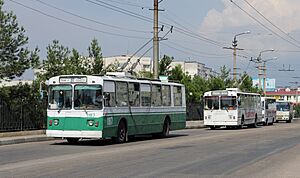
Sevastopol has many ways to get around:
- Buses: 101 lines
- Trolley buses: 14 lines
- Minibuses: 52 lines
- Cutters (small boats): 6 lines
- Ferry: 1 line
- Express buses: 15 lines
- Local trains: 1 route
- Airport: 1 (currently used for military purposes, but being rebuilt for international flights).
The Sevastopol Shipyard has three facilities. They repair, update, and re-equip Russian Naval ships and submarines.
Sevastopol has a large port in the Bay of Sevastopol and other smaller bays. The port handles passenger ships, cargo ships, and fishing boats. The port is fully connected with the city and the naval bases of the Black Sea Fleet.
Visiting Sevastopol: Tourism
Because of its military past, many streets in Sevastopol are named after Russian and Soviet military heroes. There are hundreds of monuments and plaques around the city that remember its military history.
Popular places to visit include:
- Chersonesos National Archaeological Reserve: See ancient Greek ruins.
- MP Kroshitsky Sevastopol Art Museum: Enjoy art.
- Sevastopol Museum of Local History: Learn about the city's past.
- Aquarium-Museum of the Institute of Biology of the Southern Seas: Discover marine life.
- Dolphinarium of Sevastopol: Watch dolphins.
- Monument to the Sunken Ships: A famous monument in the bay.
- The Panorama Museum: Shows the heroic defense of Sevastopol during the Crimean War.
- Malakhov Kurgan: A historic hill with a white tower.
- The Black Sea Fleet Museum: Learn about the navy.
- The Storming of Sapun-gora Diorama Museum: Shows a key battle from World War II.
- Balaklava Naval Museum: An old underground submarine base, now open to visitors.
- Museum Historical Memorial Complex "35th Coastal Battery": Another important military history site.
- The Naval Museum "Michael's battery".
People of Sevastopol
Sevastopol has a population of 547,820 people (as of January 2021). Most of these people live in the city, while about 30,598 live in rural areas. It is the most populated city in the Crimean Peninsula.
The city has always had more Russians than other ethnic groups. In 2001, the main groups were:
- Russians (71.6%)
- Ukrainians (22.4%)
- Belarusians (1.6%)
- Tatars (0.7%)
- Crimean Tatars (0.5%)
The average age in Sevastopol is about 40.2 years. For males, it's 36.0 years, and for females, it's 44.6 years.
In 2021, the average life expectancy in Sevastopol was 72.25 years. This was 67.87 years for males and 76.43 years for females.
Culture and Buildings
Sevastopol has many historic buildings, especially in the city center and Balaklava. Some of these are important architectural landmarks. The western parts of the city have more modern buildings. Recently, many tall buildings have been built. The Balaklava Bayfront Plaza, which is still being built, will be one of the tallest buildings in Ukraine.
After Russia took over Crimea in 2014, the city's monument to Petro Konashevych-Sahaidachny was moved to Kharkiv.
Learning in Sevastopol
Sevastopol has several places for higher education:
- Economics and Humanities Institute (Branch), Crimean Federal University
- Sevastopol National Technical University
- Sevastopol National University of Nuclear Energy and Industry
Famous People from Sevastopol
Many notable people have come from Sevastopol, including:
- Alla Kostromichova (born 1986): A Ukrainian fashion model and TV presenter.
- Arkady Averchenko (1881–1925): A Russian writer and satirist.
- Igor Cassini (1915–2002): A Russian-American gossip columnist.
- Aleksei Chaly (born 1961): A businessman and former mayor of Sevastopol.
- Alexander Galich (1918–1977): A Soviet poet, playwright, and singer.
- Lola Gjoka (1910–1985): An Albanian pianist.
- Rimma Kazakova (1932–2008): A Soviet/Russian poet who wrote popular songs.
- Ileana Leonidoff (1893–1968): An actress, dancer, and choreographer.
- Kseniya Mishyna (born 1989): A Ukrainian film and stage actress.
- Aleksandr Nosatov (born 1963): An admiral in the Russian Navy.
- Ivan Papanin (1894–1986): A Soviet polar explorer and scientist.
- Anton Shkaplerov (born 1972): A Russian cosmonaut.
Sports Stars
- Lyudmila Aksyonova (born 1947): A 400-meter runner who won a bronze medal at the 1976 Summer Olympics.
- Aleksandr Fyodorov (born 1981): A water polo player who won a bronze medal at the 2004 Summer Olympics.
- Svitlana Matevusheva (born 1981): A sailor who won a silver medal at the 2004 Summer Olympics.
- Alexander Onischuk (born 1975): A Ukrainian-American chess Grandmaster.
- Galina Prozumenshchikova (1948–2015): A Soviet swimmer who won five Olympic medals.
Images for kids
-
The Panorama Museum (The Heroic Defence of Sevastopol during the Crimean War)
-
The Storming of Sapun-gora of 7 May 1944, the Diorama Museum (World War II)
-
Entrance to Balaklava bay, 2010
See also
 In Spanish: Sebastopol para niños
In Spanish: Sebastopol para niños


